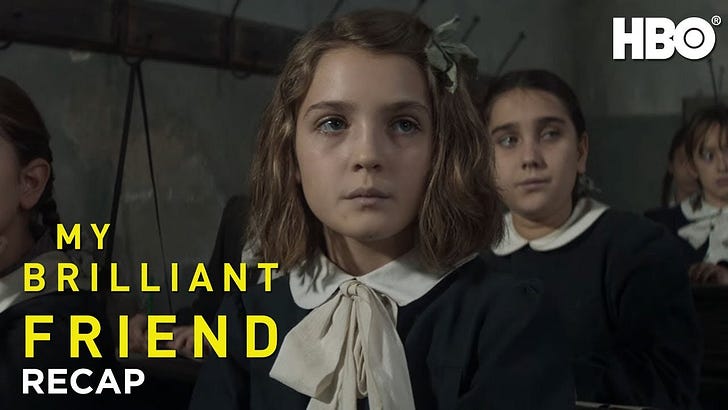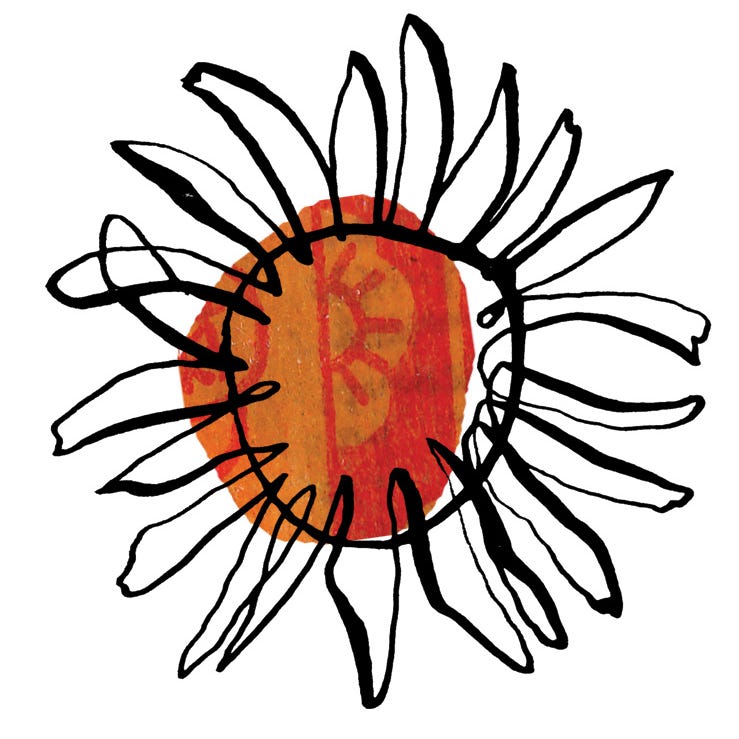Before I begin, I introduce my next guest Camilla Sanderson who writes:
My Brilliant Friend and the Tetralogy: a Theory
The 10-episode final season of My Brilliant Friend will finally debut September 9 (at 9 p.m. ET) on HBO and will stream on Max, picking up more or less where the season three finale left off: in the 1980s, set against a turbulent backdrop of political violence and social upheaval in Italy.
The Epigraph to book one My Brilliant Friend:
"The LORD: Therein thou’rt free, according to thy merits;
The like of thee have never moved My hate.
Of all the bold, denying Spirits,
The waggish knave least trouble doth create.
Man’s active nature, flagging, seeks too soon the level;
Unqualified repose he learns to crave;
Whence, willingly, the comrade him I gave,
Who works, excites, and must create, as Devil." —J.W. GOETHE, Faust, translation by Bayard Taylor
In Elena Ferrante’s Neapolitan novels, I argue that Elena aka Lenú and Lila are not only mirrored in the four books that are now an HBO popular series, but that the two are the same person. I don’t mean that the novels deceive us. Indeed, two characters strut through all the volumes.
I’m arguing that Ferrante, great novelist that she is, explores the question of identity through these two characters and that the primary consciousness is always Elena’s.
I will attempt to assert that theory here and, if you haven’t read the novels and want to, note that you may find minor spoilers in this essay though I won’t outline the plot.
First, let me address this question: Why would Ferrante do what I argue she does: One consciousness through two characters?
I believe she found this way to be not only clever, but much more profound through a deep dive into how Elena finds herself on her journey as author, lover, parent, and primarily a creative being who pursues her art, despite all odds, including her own tendencies to evade, even in some sense, drown her gift.
She is not the only one who would drown her gift, discount her worth, her writing, her brilliance: All the men she hooks herself to would do so as well if they could.
For this primary reason, I argue that the brilliance of the four novels is the mirror effect of the two characters. Lenú, who authors the four books explores the power of a brilliant, arrogant side of her who is Lila—real name Raffaella Cerullo, called Lina—and here is the first tipoff by Ferrante in her index of characters—but “by Elena Lila.” Here’s the line under “The Cerullo family: “Rafaello Cerullo, called Lina, and by Elena, Lila”
Of course, one might fairly argue that the line I quoted simply means that Elena calls Lina by the name Lila.
Ferrante is no trickster. She sets me on the path of knowing that these two are one and the same in the journey of identity on page 1 of the first novel in the tetralogy. What she does here the HBO series chose to omit. In my view, that is a mistake in the series.
On page one of the first book, Lila has disappeared. Ferrante places the stance of the narrator when both characters are sixty-six years old as the story opens with the assertion that Lila has disappeared. Or, I argue, that Lenú, our narrator, has come or is on the verge of “becoming,” a fully realized identity who no longer needs her alter ego.
We find this Lenú at the close of book four.
Elena tells us on p. 2 of book one My Brilliant Friend: “It’s been at least three decades since she told me that she wanted to disappear without leaving a trace, and I’m the only one who knows what she means. She never had in mind any sort of flight, a change in identity, the dream of making a new life somewhere else. And she never thought of suicide, repulsed by the idea that Rino [her son, who is forty at the book’s opening] would have anything to do with her body, and be forced to attend to the details. She meant something different: she wanted to vanish; she wanted every one of her cells to disappear, nothing of her ever to be found. And since I know her well, or at least I think I know her, I take for granted that she has a way to disappear, to leave not so much as a hair anywhere in the world.” (This paragraph appears on the second page of the novel’s opening text.)
Without revealing the plot, I continue to argue that by book 4 The Story of the Lost Child, Elena, our narrator, has emerged full force as a separate and fully realized identity. She says about Lila on the last page, “Here’s what she has done: she had deceived me, she had dragged me wherever she wanted, from the beginning of our friendship. All our lives she had told the story of redemption that was hers, using my living body and my existence.” (Ferrante’s italics)
Could Ferrante be any more clear about what she is about than this revelation before the unfolding of the tale begins and at its close?
I add, the very fact that Ferrante chooses to remain anonymous somehow, arguably, supports my theory that the discovery of self is key to identity. No name will serve for that search.
I argue that with all the layers of these extraordinary books, the essence is identity, how we find ourselves and flourish.
I don’t know that anyone else has argued this. And, of course, I could be wrong.
If you have read the novels, do tell me: What do you think?
My P.S.: In the film of Ferrante’s The Lost Daughter, director Maggie Gyllenhaal splits the “mother” into two roles. As a mirror of the interior monologue in the novel, Gyllenhaal decided to use two actresses: one as the main character and another as her younger self. Exploration again of identity?
An added note of similarity among the novels: Ferrante uses dolls in The Lost Daughter, and she uses them in the quartet: The Neapolitan novels. Perhaps that imagery works to parallel the mirroring in the quartet and in this novel as well as Gyllenhaal’s interpretation as director of the film.
Here’s an excerpt from Gyllenhaal’s interview with Kara Swisher of The New York Times:
Kara Swisher: This movie is told through two interwoven timelines … the present day mother of adult children who’s holidaying solo in Greece, played by Olivia Colman, and the young mother who’s steeped in the mess of childhood tantrums and a budding career, played by Jessie Buckley. You split the mother in two, effectively, correct?
Maggie Gyllenhaal: Oh, that’s interesting. Maybe I split the mother in two in order to ultimately bring the mother together, you know? I mean, I think we’ve been used to for, you know, in most of the films and books and representations of motherhood, splitting the mother in two, right? The bad mommy and the fancy mother.
So I think, for me, I was listening to your intro where you were saying that she’s an unnatural mother. I don’t think I agree with that. I think even the concept of an unnatural mother is, it’s just something to be thought about, weighed in your hands. She uses that— that’s a straight lift from Ferrante, that phrase. And I was really compelled by it. And in fact, I think it’s sort of— it’s almost like a puzzle that can’t be solved. It’s, of course, if she’s an unnatural mother, well, what is a natural mother? That’s the expectation on us.
Swisher: Yeah, that everybody should be one. I think she was actually saying uncomfortable, uncomfortable or awkward, or it doesn’t come naturally, like other things, which I think is interesting. I think the more disturbing sentence was motherhood is a crushing responsibility and the word crushing. But let me ask you, Leda calls her an unnatural mother. You don’t actually think she is, in other words.
Gyllenhaal: I don’t, no. I think it’s way too simple. I think what that is meant to do in the movie is kind of reverberate against itself. If she calls herself an unnatural mother, well, what is a natural mother, you know? And I think when you are asking sort of, how am I seeing the movie now or what is the purpose or the intention, I mean, and there’s a lot of answers to that question, but one of them is to normalize all sorts of feelings, not just about mothering, but also just in general about being a woman in the world so that if you have a whole bunch of those feelings in aspects of yourself, you don’t then feel that you’re monstrous and unnatural.
Interview with Maggie Gyllenhaal on directing The Lost Daughter
PPS: With my thanks to Mary Nash, reader and friend, I’ve now also read Days of Abandonment, Ferrante’s earlier novel published in 2005. I have another theory for your unbelief, surprise and comment: Elena Ferrante and Jane Austen have more in common than you might think: Though the styles are quite different and Austen gives us happy endings, both understand anger and write anger with precision and power, stories that resonate and last.
Mary Tabor writes







I'm inclined to agree with you, Mary, and I appreciate this careful execution of your theory. Ferrante's (and Gyllenhall's) brilliance, at least in part, is how they recognize that just below the surface for so many women is this shadow, opposite, or inverse picture of womanhood in its many "identity" forms as mother, daughter, sister, friend, etc. It looks so bold to show women upending proper categories; Ferrante simply knows: we do not fit them. We only try to fit them. And when we don't it may be th most natural thing -- to be who we are -- but it looks brave or radical to speak it, or at least profoundly unsettling. So when you look at Elena and Lina as the same woman, in a sense, I get it.
I stopped reading early on because I'm well reminded that I need to watch this series, and I don't want to be influenced by your ideas, though I I caught the early one about the two characters being metaphorically the same person. I'll binge now to catch up for season 4.